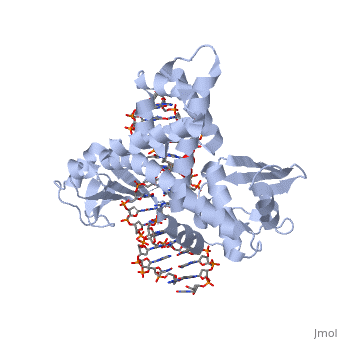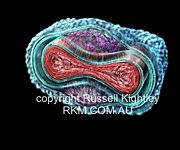Variola Topoisomerase 1B
From Proteopedia
[1]
General Functions of the ProteinVariola Topoisomerase is a Type 1B topoisomerase present in the poxviruses, the causative agent of smallpox[2]. As with most DNA encoded viruses, the poxvirus utilizes Type IB topoisomerase to relieve supercoils during processes such as replication, transcription, and repair[3]. To accomplish this relief, the enzyme nicks a single strand of the DNA molecule of interest, allowing rotation around the uncleaved strand[4]. This action removes between 5 to 14 superhelical turns each time the DNA molecule is nicked[4]. In order to better understand the mechanism of Variola Topoisomerase's major function, we will first look at the structural details. See also Smallpox (Variola Virus) - Topoisomerase 1B. Structural DetailsVariola Topoisomerase is one of the smallest known topoisomerases, measuring a mere 34 kDA[5]. The enzyme is folded into two domains: [2]. The N domain consists of a 5 stranded antiparallel beta sheet (labeled β1-5) and 2 alpha helixes (labeled α1-2) twisted together[2]. The catalytic domain consists of a 3 stranded beta sheet (labeled β6-8) and alpha helixes(labeled α4-12)[2]. The catalytic domain sits on the minor groove face while the active is positioned on the major groove face of the DNA sequence. The two domains are bound by the core sequence 5'-CCCTT-3'[4]. This binding creates the observable C-shaped clamp surrounding the DNA molecule being acted upon[4]. The non-covalently bound complex has a salt bridge not observed in the covalently bound complex. The connects the Lys65 found within the N domain to the Glu139 of the catalytic domain[2]. The enzyme can either be covalently or non-covalently bonded to the DNA molecule only differing at the active site. Active SiteThe key residue for the differences observed between the covalently and non-covalently bound states is Tyrosine 274[2]. When cleaving the single strand of DNA, Tyr274 acts as a nucleophile attacking the hydroxyl group of the O'5[2]. When ligating the strand back together, the roles reverse, allowing the 5' hydroxyl group to nucleophilicly attack the Tyr274 residue[2]. Amazingly, the enzyme is able to alter between these two bound states without utilizing any high energy cofactors, though there are several other significant residues within the active site that promote this mechanism, namely [2]. Three residues of the active site serve to stabilize the buildup of negative charges in the transition state as Tyr274 nucleophilically attacks: Arg130, Arg223, and His265[2]. This is accomplished by the residues forming hydrogen bonds to the scissle phosphate[2]. Lys167 makes direct contact with the DNA molecule at the +1 base of the scissle phosphate[2]. In order to make the O5'-hydroxyl group a better leaving group, the Arg130 and Lys167 residues contribute to the protonation of the hydroxyl group[2]. Currently, a water molecule found within the active site is theorized to act as the acid/base catalyst for Tyr274 hydroxyl group[5]. In the non-covalently bound complex, the measured distance of the is approximately 8Å[2]. Thus, during the conformation change, i.e. the movement of the α10a-α10b segment, results in the movement of the Tyr274 residue by approximately 3.6Å[5]. Downstream InteractionsIn addition to the active site, Variola Topoisomerase 1B has downstream contacts that assist with its binding to the DNA. There are four different interaction points of Topoisomerase that interact for this purpose: the N-terminal domain, the conserved β turn, the α9 helix, and the α10a helix[5]. First, Lys35 and His39 side chains on the N-terminal domain form hydrogen bonds and van der Waals interaction with the uncleaved DNA strand[5]. In the conserved β turn, adjacent to the cleavage site, Asp168 makes contact with the DNA at the -1 sugar[5]. The forms a water-mediated hydrogen bond with N3 of +A on the uncleaved strand[5]. During the transition state, it also interacts with sugars on the opposite face of the minor groove[5]. This includes contact with carboxylate oxygen and carbon atoms of the -1A sugar, the leaving group during the cleavage of DNA, and the +1 sugar of the uncleaved strand[5]. The CH-O bonds made by Asp168 influences ring position and allow Lys167 to affect the torsion angle of the C4’-C5’ bond[5]. Through these interactions, Asp168 serves to promote ligation, by catching the rotating downstream DNA and positioning it for ligation[5]. The rest of the downstream interactions occur in the α9 and α10a helices of Topoisomerase 1B[5]. The α10a helix is in the major groove and interacts with the nucleotides -3 to -1 on the cleaved strand to influence the rate of DNA cleavage[5]. Three main amino acids assist with the interaction: . Thr266’s amide nitrogen and hydroxyl group hydrogen bond to the -1/-2 phosphate[5]. Meanwhile, Arg272 bridges the O4 groups of the -2T and -3T bases with hydrogen bonds[5]. Ille269 facilitates van der Waals interactions with the -2T base and the -1A sugar[5]. In addition to these three, Lys271 interacts with the -5/-6 phosphate on the noncleaved strand[5]. All of these interactions are essential because the α10a also includes Tyr274 at its C-terminus[5]. These interactions allow the correct positioning of this essential catalytic residue. The last important downstream contact site is approximately 10bp downstream of the catalytic site at the α9 helix[5]. In this helix, Lys250 and Lys249 hydrogen bond to the -10/-11 phosphate and Lys249 to the -6/-7 phosphate of the uncleaved strand[5]. Additionally, Ala253 forms hydrogen bonds with the sugar-phosphate backbone of the uncleaved strand, pulling it within a distance of 4.3Å[5]. These interactions allow the DNA to come in close proximity to the Topoisomerase 1B. SpecificityWhat gives Variola Topoisomerase its specificity is that it can only cleave and ligate DNA at a pentapryimidine sequence 5'-(T/C)CCTT-3'[4]. More specifically, this is a phosphate group found after the 3'-terminal thymidine[4]. Cleavage at this specific sequence is a nearly impossible feat for human strains of Type I Topoisomerases[4]. The beta 5 strand of the N domain makes 3 direct contacts with the major groove face of the DNA molecule at positions Tyr70, Tyr72, and Gln69[2]. Tyr70 hydrogen bonds to the phosphate backbone while also interacting with the Cyt+3 and Cyt+4 bases[2]. Tyr72 also hydrogen bonds to the phosphate backbone while interacting with the +3 ribose ring and the Thy+2 base[2]. Gln69 makes a double hydrogen bond with Ade+2[4]. The variola strain also shows a talent for discriminating against DNA strains with mismatches, giving greatest significance to those at the 1', 2', or 3' positions relative to the cleavage site[4]. Studies have shown that the equilibrium constants and reversible strand ligation forward rate will decrease 10 times when these mismatches are present[4]. See AlsoReferences:
| ||||||||||||


